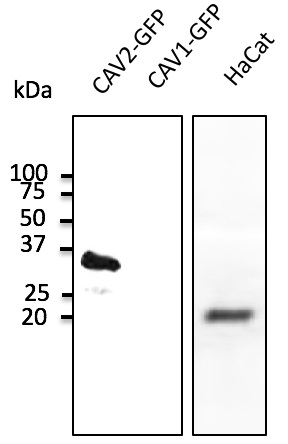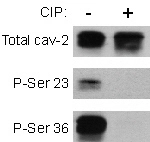Caveolin 2 antibody
GTX108294
ApplicationsImmunoFluorescence, ImmunoPrecipitation, Western Blot, ImmunoCytoChemistry, ImmunoHistoChemistry, ImmunoHistoChemistry Paraffin
Product group Antibodies
TargetCAV2
Overview
- SupplierGeneTex
- Product NameCaveolin 2 antibody
- Delivery Days Customer9
- Application Supplier NoteWB: 1:500-1:3000. ICC/IF: 1:100-1:1000. IHC-P: 1:100-1:1000. IP: 1:100-1:500. *Optimal dilutions/concentrations should be determined by the researcher.Not tested in other applications.
- ApplicationsImmunoFluorescence, ImmunoPrecipitation, Western Blot, ImmunoCytoChemistry, ImmunoHistoChemistry, ImmunoHistoChemistry Paraffin
- CertificationResearch Use Only
- ClonalityPolyclonal
- Concentration0.94 mg/ml
- ConjugateUnconjugated
- Gene ID858
- Target nameCAV2
- Target descriptioncaveolin 2
- Target synonymsCAV, caveolin-2, caveolae protein, 20-kD
- HostRabbit
- IsotypeIgG
- Protein IDP51636
- Protein NameCaveolin-2
- Scientific DescriptionThe protein encoded by this gene is a major component of the inner surface of caveolae, small invaginations of the plasma membrane, and is involved in essential cellular functions, including signal transduction, lipid metabolism, cellular growth control and apoptosis. This protein may function as a tumor suppressor. CAV1 and CAV2 are located next to each other on chromosome 7 and express colocalizing proteins that form a stable hetero-oligomeric complex. Two transcript variants encoding distinct isoforms have been identified for this gene. By using alternative initiation codons in the same reading frame, two isoforms (alpha and beta) are encoded by one transcript. [provided by RefSeq]
- Storage Instruction-20°C or -80°C,2°C to 8°C
- UNSPSC12352203
References
- Dong X, Song Q, Zhu J, et al. Interaction of Caveolin-3 and HCN is involved in the pathogenesis of diabetic cystopathy. Sci Rep. 2016,6:24844. doi: 10.1038/srep24844Read this paper






